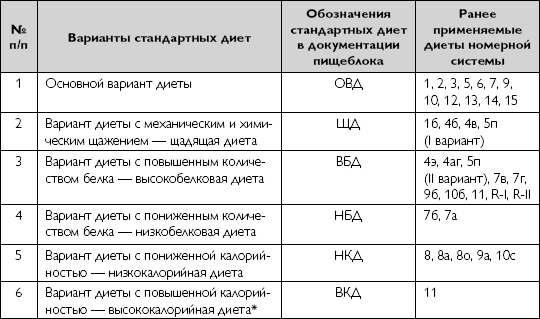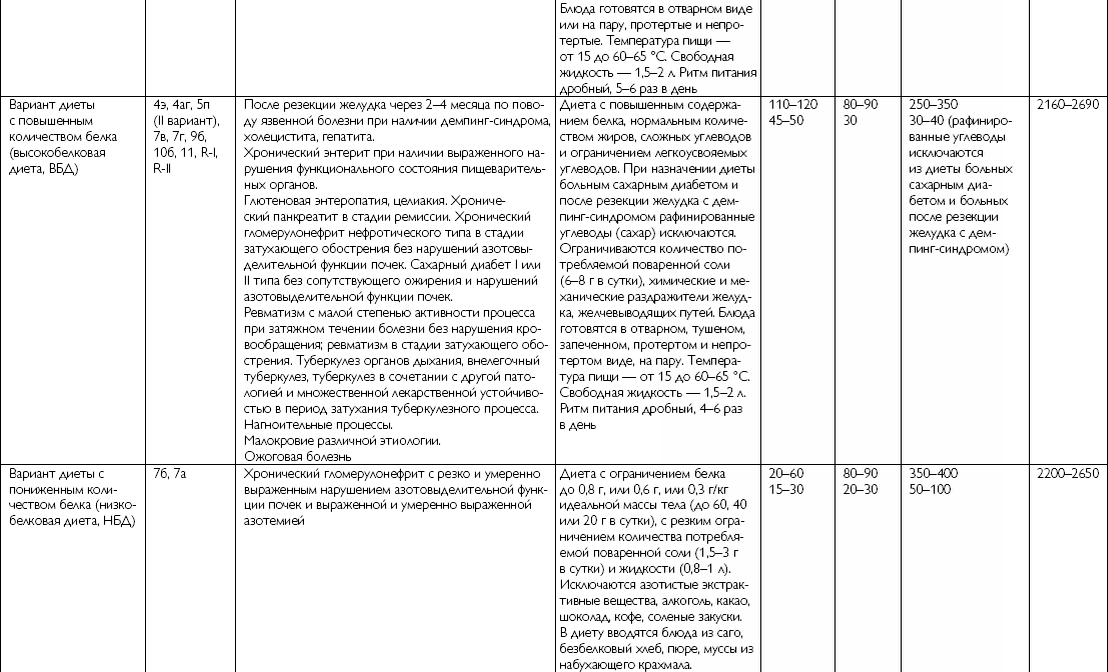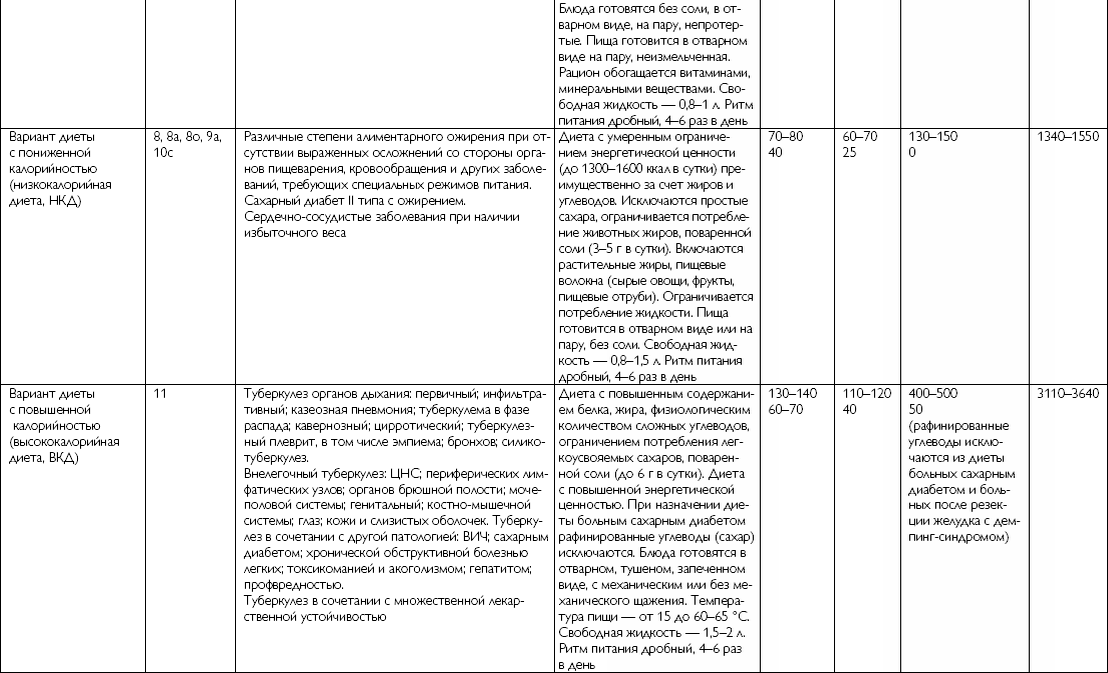Chapter 3 The system of standard diets for medical nutrition Dietary medical nutrition is based on the physiological needs of a healthy person for nutrients and energy,
Chapter 3 System of standard diets for therapeutic nutrition
Dietary medical nutrition is based on the physiological needs of a healthy person for nutrients and energy, which are corrected based on the characteristics of pathogenesis, clinical course, stage of the disease, the severity of metabolic disorders, risk factors for the development of alimentary-dependent diseases in each individual patient.
Numerous studies on the mechanisms of food assimilation in normal conditions and in various diseases formed the basis for the development of the first concept of balanced nutrition, and then concept of optimal nutrition, according to which the chemical structure of the diet and its nutritional, biological and energy value should correspond to the functional state of the body's enzyme systems responsible for the assimilation of nutrients, provided that the body's need for basic nutrients, essential nutritional factors and energy is fully met.
It is more correct to consider the complex and essentially unified process of food assimilation in a certain sequence and at different levels of food assimilation: at the level of food perception and digestion in the gastrointestinal tract, at the level of receipt of food digestion products into cellular structures and their transformation in intracellular structures and, finally, at the level of excretion of metabolic products from the body.
Until 2003, medical nutrition in medical institutions (HCIs) of the USSR and the Russian Federation was built according to the nosological principle in the form of dietary rations developed at the Clinic for Clinical Nutrition of the Federal State Budgetary Institution Research Institute of Nutrition of the Russian Academy of Medical Sciences and approved by the USSR Ministry of Health, in relation to each specific disease, which were designated by numbers from 1 to 15. The number system of diets included 15 basic diets and their numerous modifications depending on the characteristics of the course of a particular disease. In total, more than 60 options for dietary tables have been developed. In practical diet therapy, with all the variety of nosologies, five diet options were mainly used – No. 1, 5, 7, 9 and 15. The number system was convenient for organizing group, rather than personalized (individualized) nutrition.
The basis for determining the quantitative proportions of the individual components of the diet are the physiological needs of a healthy person's body for nutrients and energy, corresponding to gender, age, body weight, energy consumption level, climatic and geographical conditions, etc., taking into account individual habits and national nutritional characteristics.The physiological proportions of nutrients include adjustments, taking into account the modified disease, the need for macro and micronutrients of each particular patient.
Before approving the order of the Ministry of Health of the Russian Federation dated 05.08.2003 No. 330 "On measures to improve therapeutic nutrition in therapeutic and preventive institutions of the Russian Federation" the main documents regulating the organization of therapeutic nutrition in the LPU were orders of the USSR Ministry of Health from 04.23.1985 . № 540 "On improving the organization of medical nutrition in medical institutions" and dated June 14, 1989 No. 369 "On the change and addition of the Order of the USSR Ministry of Health".
Order of the Ministry of Health of Russia dated 08/05/2003 No. 330 "On measures to improve therapeutic nutrition in therapeutic and preventive institutions of the Russian Federation" a new range of diets was introduced (system of standard diets), which combines previously used license system diet (diet number 1-15 ).
The system of standard diets in accordance with this order included five options for standard diets: the main version of the diet (ATS), the version of the diet with mechanical and chemical gene (gentle diet, a shch), a variant of a diet with an increased protein (high-protein diet, VBD), A variant of diet with a reduced amount of protein (low-facility diet, NBD), a reduced calorie diet option (low-calorie diet, NKD). The system of standard diets is presented in Table 7.
Standard diets in their chemical composition and energy value are adapted to the peculiarities of pathogenesis, clinical flow, the disease stage, the nature of metabolic disorders of the main and related diseases.
Standard Diet System

* Until 201 3 G. – High-facility diet for patients with Tuberculosis VBD (T) (order of the Ministry of Health and Social Development of Russia dated April 26, 2006 No. 316).
In subsequent years, the Ministry of Health and Social Development of the Russian Federation was published a number of orders, which made changes and additions to the order of the Ministry of Health of Russia dated 05.08.2003 No. 330. So, in accordance with the order of the Ministry of Health and Social Development of Russia dated April 26, 2006 No. 316 " On Amendments to the Order of the Ministry of Health of the Russian Federation "On measures to improve therapeutic nutrition in therapeutic and preventive institutions of the Russian Federation" a second version of a high-protein diet for patients with tuberculosis – VBD (T) was introduced into the standard diet system.
On June 21, 2013, in order to implement the Federal Law of the Russian Federation of 21.11.2011. No. 323 "On the basics of the health of citizens in the Russian Federation", the Ministry of Health of the Russian Federation issued an order No. 395n "On approval of the norms of therapeutic nutrition". In accordance with this order, the version of a high-protein diet for tuberculosis patients (VBD (T)) is replaced with an increased calorie diet (high-calorie diet, CPM), taking into account the fact that this version of the standard diet along with an increased protein and fat content is characterized by high calorie content .
Characteristics, chemical composition and energy value of standard diets used in medical organizations



This text is an introductory piece.
Continued on LitRes
Read also
"Dieta" means "nutrition system"
"Dieta" means "nutrition system" In Spain they say: "The Mediterranean diet is back in fashion." The most common advice that doctors and nutritionists have been giving to the population lately is to return to the basics of a healthy diet. “How so?” the reader will ask:
Oleg Lamykin This tasty and healthy life. Complete system of nutrition and cleansing of the body
Oleg Lamykin This tasty and healthy life. A complete system of nutrition and cleansing of the body Dedicated to my beloved wife, who selflessly guards me and inspires all these
Nomenclature of dietary tables (developed at the Clinic for Clinical Nutrition of the Institute of Nutrition of the Russian Academy of Medical Sciences)
The nomenclature of dietary tables (developed at the Clinic for Clinical Nutrition of the Institute of Nutrition of the Russian Academy of Medical Sciences) Diet No. 1 Peptic ulcer of the stomach and duodenum in the stage of fading exacerbation and compensation; chronic gastritis with
Characteristics of diets and sample menus for diseases of the cardiovascular system (developed by the Clinic for Clinical Nutrition of the Institute of Nutrition of the Russian Academy of Medical Sciences)
Characteristics of diets and sample menus for diseases of the cardiovascular system (developed by the Clinic for Clinical Nutrition of the Institute of Nutrition of the Russian Academy of Medical Sciences) Diet No. 10 Indications for the diet. Various diseases of the heart and blood vessels with mild circulatory disorders.
Purpose of the type of medical nutrition
Assignment of the type of therapeutic nutrition The first option: it is prescribed to patients with normal body weight in the absence of pronounced violations of the nutritional and metabolic status. A diet with a physiological content of proteins, fats and carbohydrates, enriched with dietary fiber,
Sports and our nutrition system
Exercise and our nutrition system I am a big fan of exercise and its impact on health. But I don't understand what's the point of wasting time without your family and friends when you spend hours on it thinking you need crazy weight loss exercises that create

